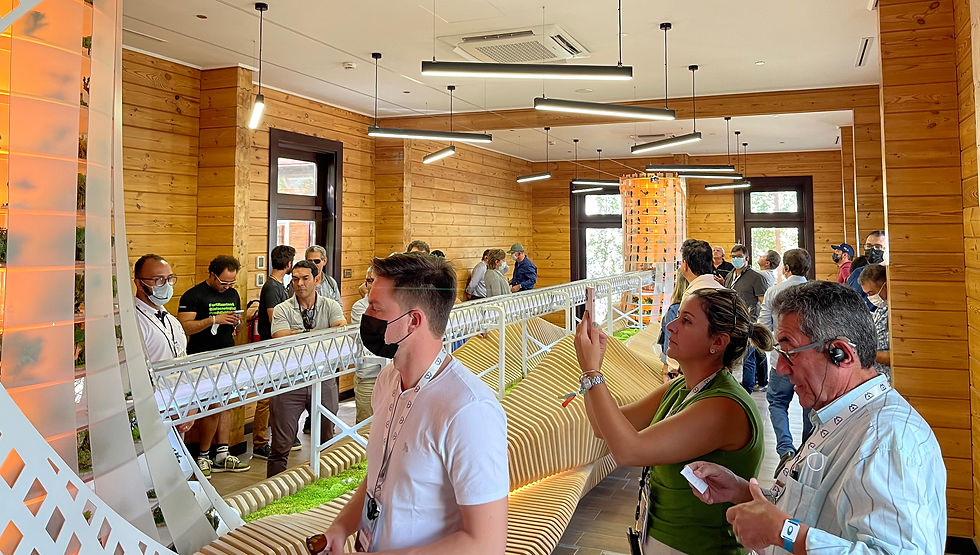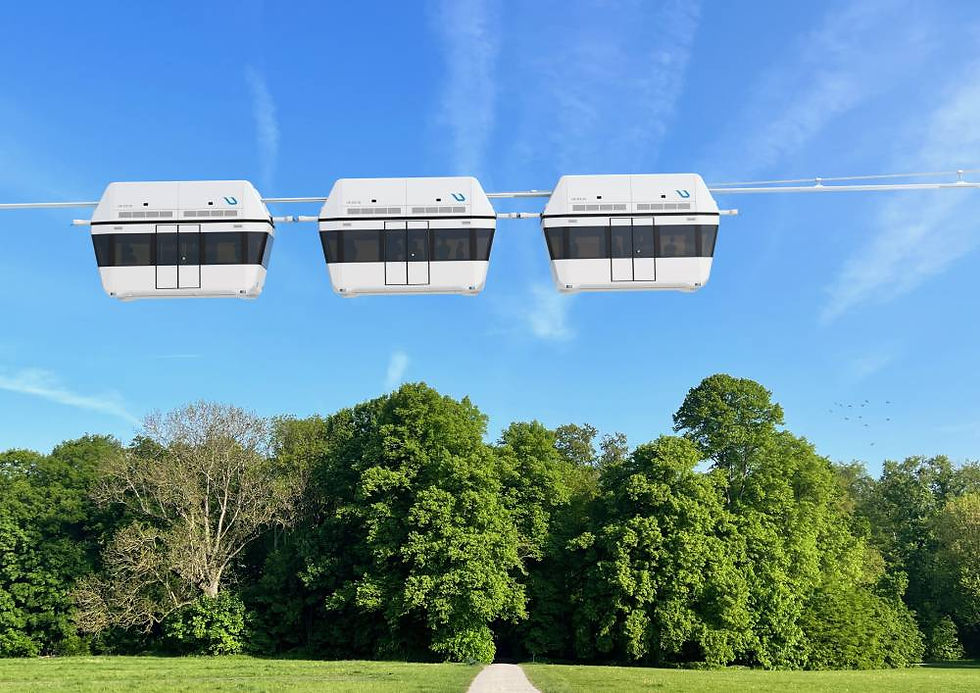uCity is the city of the future in harmony with nature
- author

- Apr 4, 2022
- 4 min read
[04.04.2022]
uSky Transport is thrilled and proud to present the concept of the linear uCity, an eco-friendly city with developed public transportation, green energy, and a highly developed economy.

uCity represents pedestrian clusters linked to each other through the networks of transport, energy, and other engineering and communication channels.
A linear city cluster is a multifunctional modular settlement. The clusters are located near key infrastructure points of a country or large city. The connection between the clusters is provided by urban rail electric vehicles on steel wheels – uPods traveling at the speed of up to 150 km/h. Each such cluster can host up to 5 thousand people for comfortable well-being.
The construction of the linear uCity cluster follows the principle of Smart City with the land designated for pedestrians and plantations. The mainstay of the cluster is pedestrian areas with low-rise comfortable residential buildings with ubiquitous greening of rooftops and urban districts, as well as with the use of renewable energy sources.
The distinguishing element of each cluster is a multifunctional dominant building with a built-in rooftop station for uSky transport system running in spans up to 1.5 km long to the next dominant in the neighbouring cluster. Apartments, hotels and shops, restaurants and cafes, business centres and stations, museums and theatres, and sports and entertainment venues will be placed in the cluster building.

Cluster size is 1–1.5 km (area 1–2 km), which is optimal for the pedestrian accessibility to infrastructure and uSky Transport stations, which excludes the need for daily use of a personal car and traditional public urban transport means (bus, tram, trolleybus, taxi, monorail, cable car, underground and overground metro, etc.).
In the future, the construction of a single linear type cluster will be able to serve as a pilot project for the creation of a linear city – uCity – with a length of tens, hundreds, and even thousands of kilometres consisting of a series of clusters interconnected by intercity uSky transport lines with 500 km/h high-speed uFlashes.

uSky transport lines represent rail string track structure combined with power and communications lines and located above the ground surface at a height of about 10 m. The ground itself is left for pedestrians and green plants. Therefore, transport in the uCity cluster will be characterized by unprecedented safety, comfort, and environmental friendliness in urban and intercity traffic.
uSky intellectual control system comprises subsystems for control, positioning, motion, passenger interaction, power supply, communications, etc.
There will be medical institutions, sports grounds, schools, kindergartens, and shopping centres within the territory of clusters. In each residential cluster or neighbouring designated clusters (production, scientific, shopping and entertainment, recreational clusters), the entire infrastructure will be located
within accessible walking distance.
All engineering technologies in the cluster, including energetic, transport, agricultural, etc. are biospheric and aimed at eliminating the negative impact on nature.
Clustered linear uCity harmoniously fits into any existing natural landscape without negative impact on local and global ecosystems including their biogeocenosis.

For this new type of residential cluster, a design of the eco-houses with a renewable energy system has been developed. The main idea of the eco-house is zero impact on the environment and protection of human health. This is an ideal place to form an auspicious microclimate for a person – optimal humidity, air quality, temperature, etc. Such a house is an independent ecosystem that provides residents not only with power and heating/cooling but also with organic food grown in the house and on the plot. The roof of the eco-house is a high-tech greenhouse suitable for year-round vegetable and fruits cultivation with the help of specially created highly fertile soil.
Residential buildings are combined into a single architectural and functional system – a multiapartment horizontal skyscraper, i.e. a high-rise building “lying on its side”. The length of each skyscraper can vary in a fairly wide range from 100 m to 1 km. Each house with a total area of 300–600 m² is designed for a family of 3–5 or more people. Houses have 3 floors: basement, residential floor, and attic.

Each cluster is provided with all requisites made in-house like organic food, artesian water, solar energy, environmentally friendly off-the-ground EVs as well as all necessary services a modern settlement may need. This will provide foodstuff, energy and infrastructural security to the linear city even in the context of pandemics and lockdowns, or other natural or man-made disasters.
The cluster is an independent economic unit, where an added value is created. Creating products, and providing services with tax revenues to the budget is feasible without leaving the cluster.
The benefits of the linear city cluster for a state are but not limited to:
reduction of dependence on exhaustible hydrocarbon raw materials (natural gas, oil),
development and connection of isolated, poor populated, and hard-to-reach territories, linking all the regions of the country into a united economy with a highly efficient linear infrastructure;
combination of the track structure with power lines and fibre optic communications lines will create a unified system for the movement of passengers and goods, power energym and data;
decentralization of large cities, uniform resettlement of the population throughout the country, and exploration of new territories (mountains, taiga, sea shelf, etc.).

The linear settlement of modern cosmopolitan cities will contribute to the uniform development of peripheral territories. Linear uCity has enormous land potential. It doesn't uptake any ground for roads, or buildings and structures, since the soil resulting from the excavation for the foundations will be enriched with humus and moved to the greenhouse rooftop. Such soil becomes highly productive, “green”, even if it was the sand of the desert before. As for existing multimillion cities, their resettlement would mean the way out of the infrastructural, transport, and environmental crises.
The relevance of this project is grounded by the urgent need to solve global modern problems like lack of resources, overpopulation of the cities, environmental problems, obsolescence of historically developed, residential, industrial, and transport infrastructure.
The construction and operation of a biospheric-type cluster will contribute to the program of restarting the economy of any country based on the introduction of natural technologies in industrial, residential and transport infrastructures, energy and agriculture – this is the way out of the social, resource and environmental crises in which the modern humanity has found itself.
The linear city model with five various types of uSky tracks is available at uSky Test & Certification Centre. Representatives from Brazil, the United Arab Emirates, Vietnam, the Dominican Republic and the Republic of Haiti, Romania, the Czech Republic, and many other guests have already familiarized themselves with it.









